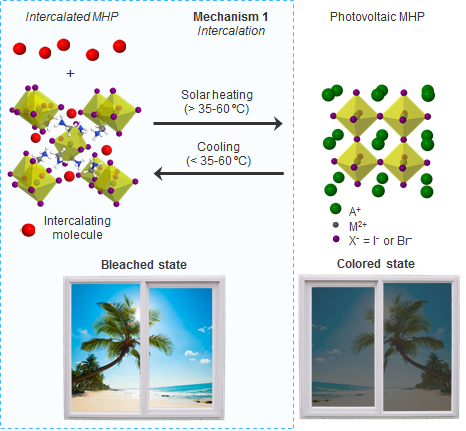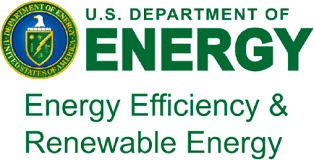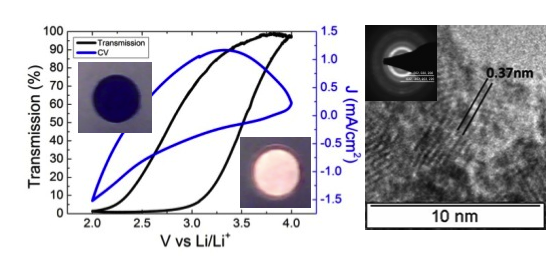Smart Windows
 Building are responsible for ~30% of the energy consumption in the US. Heat gain and heat loss through windows
are responsible for 25%–30% of residential heating and cooling energy use. Smart windows can reversibly change
their transparency to alter the solar heat gain coefficient (SHGC). Most smart windows are passive. In a new
collaborative project with NREL we are developing smart windows based on perovskite
solar cells that also generate power when they darken. Their patented "SwitchGlaze" technology is illustrated at left.
Upon illumination the device heats up and an intecalating gas evolves, allowing the film toform the opague
perovskite photovoltaic. Upon cooling the gas returns, disrupting the crystal structure and returning
transparency. The process is completely reversible, but volume expansion in the conventional planar architecture leads
to degradation during cyling. PhD candidate Kevin Prince's contribution to this project
is helping to develop novel all back contact architectures to improve the lifetime of these devices.
Building are responsible for ~30% of the energy consumption in the US. Heat gain and heat loss through windows
are responsible for 25%–30% of residential heating and cooling energy use. Smart windows can reversibly change
their transparency to alter the solar heat gain coefficient (SHGC). Most smart windows are passive. In a new
collaborative project with NREL we are developing smart windows based on perovskite
solar cells that also generate power when they darken. Their patented "SwitchGlaze" technology is illustrated at left.
Upon illumination the device heats up and an intecalating gas evolves, allowing the film toform the opague
perovskite photovoltaic. Upon cooling the gas returns, disrupting the crystal structure and returning
transparency. The process is completely reversible, but volume expansion in the conventional planar architecture leads
to degradation during cyling. PhD candidate Kevin Prince's contribution to this project
is helping to develop novel all back contact architectures to improve the lifetime of these devices.
This project is lead by Dr. Lance Wheeler's at NREL and supported by DOE's Office of Energy Efficiency and Renewable Energy.


 In this completed project our group developed ultrasonic spray deposition (USD) for the scalable fabrication
of electrochromic smart windows. Electrochromic materials like tungsten oxide reversibly alternate between transparent and dark in response
to an applied electrical field. Advantages of USD include low capital requirements and high materials utilization.
In our first approach crystalline WO3 nanoparticles (NP) were produced by hot-wire chemical deposition.
The resulting NPs were then suspended in an ethanol solution and sprayed to form mesoporous films using USD.
The electrochromic performance improved as the NP size was reduced, but it proved difficult to reduce the NP size beyond
15 nm using HWCVD or produce NPs in the quantities required for large scale manufacturing.
We then demonstrated that templated sol-gel chemistry could be adapted to USD. Systematic manipulation of sol
chemistry enabled the production of micron thick films with high specific surface area (>100 m2/g),
mean pore sizes of ~5 nm, and narrow pore size distributions. These films display unrivaled electrochromic performance,
modulating >98% of incident solar radiation in the visible spectrum (450 – 900 nm). Elimination of haze enables
full transmission in the bleached state, while the broadband coloration is attributed to the exceptionally high
charge density (> 120 mC/cm2). These results suggest that USD offers a pathway for scalable fabrication
of the numerous mesoporous materials that have been derived using templated sol-gel chemistry.
In this completed project our group developed ultrasonic spray deposition (USD) for the scalable fabrication
of electrochromic smart windows. Electrochromic materials like tungsten oxide reversibly alternate between transparent and dark in response
to an applied electrical field. Advantages of USD include low capital requirements and high materials utilization.
In our first approach crystalline WO3 nanoparticles (NP) were produced by hot-wire chemical deposition.
The resulting NPs were then suspended in an ethanol solution and sprayed to form mesoporous films using USD.
The electrochromic performance improved as the NP size was reduced, but it proved difficult to reduce the NP size beyond
15 nm using HWCVD or produce NPs in the quantities required for large scale manufacturing.
We then demonstrated that templated sol-gel chemistry could be adapted to USD. Systematic manipulation of sol
chemistry enabled the production of micron thick films with high specific surface area (>100 m2/g),
mean pore sizes of ~5 nm, and narrow pore size distributions. These films display unrivaled electrochromic performance,
modulating >98% of incident solar radiation in the visible spectrum (450 – 900 nm). Elimination of haze enables
full transmission in the bleached state, while the broadband coloration is attributed to the exceptionally high
charge density (> 120 mC/cm2). These results suggest that USD offers a pathway for scalable fabrication
of the numerous mesoporous materials that have been derived using templated sol-gel chemistry.
Support for this work was provided by the National Science Foundation through
the Renewable Energy Materials Research Science and Engineering Center
in collaboration with Dr. Rob Tenent’s group at NREL.


